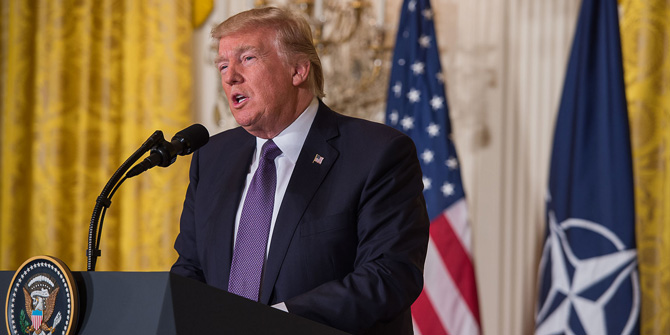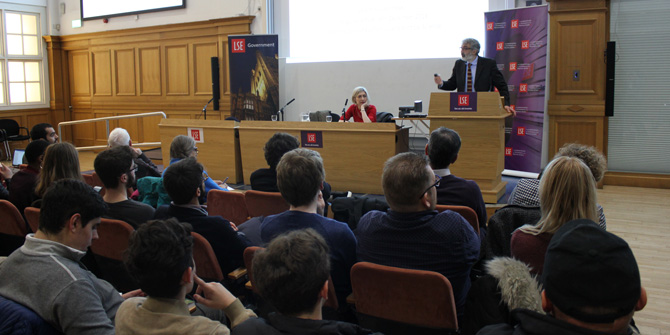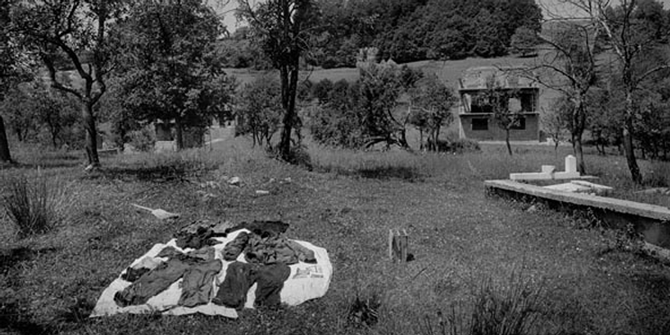
Sarah Fowler reviews our recent public event on Wednesday 31 October 2018 titled ‘Politics as Performance: will the American fascination with ‘Trump style’ survive the 2018 midterms?’, which was hosted by the LSE Department of Government and the US Centre.
As the United States prepared for the 2018 midterms, which took place on 6 November 2018, campaigns for all levels and positions were throwing money, time, and publicity into the last days before ballots were cast. The nation waited to find out what this week would bring: would there be a “blue wave” and a balancing of the status quo, or, as Visiting Senior Fellow in the LSE Department of Government Erik Bucy discussed in his talk at LSE, would “Trump style” continue to resonate with voters and the populist surge survive the midterms?
In a fascinating break from the typical pundit discussion of “who’s up and who’s down” and “red vs blue” we usually see before an election, Bucy approached the concept of populism and whether it will remain a powerful force in US politics in the near future from the perspectives of information processing and biobehavior. He began by discussing how, in an increasingly confusing and noisy media and political sphere in which some people deal in facts and others simply don’t, it can be hard to sift through the constant barrage of information, misinformation, and disinformation and discern whether you’re faced with BS (that is, indifference to the truth) or outright and intentional lies. His solution is to shut off the noise and turn instead to nonverbal indicators.
Nonverbals in Politics
Bucy pointed out that although we prioritise language, both in politics and our everyday lives, we are constantly processing information via other sensory indicators, especially vision. Just as we can form judgements about a situation on the basis of an image alone, so too do we form judgements about a person based on their expressions, gestures, and other nonverbal indicators such as posture and tone of voice that are often distinct from those we form based on their words or actions. Bucy illuminated this point by explaining that when shown short video clips from debates with varying levels of audio (full sound, garbled, and no sound), viewers who watched the footage with no sound were more accurately able to predict election winners than those who watched with full sound. With the sound on, however, viewers are better able to identify a politician’s political party.
Investigating such phenomena is part of Bucy’s program of research on media biopolitics which focuses on documenting the types and effects of televised leader displays on voters. Leadership has a large nonverbal component and political visuals can serve as reliable sources of social information, not only because they are easy to process, Bucy argues, but because they require minimal literacy. As an equalising agent of communication, visuals are able to level some knowledge gaps we see in the electorate and resonate with a wider constituency. This is largely due to the fact that gestures, expressions, and body language typically convey emotion and motivational intent far more accurately than words.
Effectively assessing nonverbal behavior can be achieved through bio-behavioural coding, which employs detailed criteria for classifying communicative displays. For example, a display of anger often indicates a motivation of threat, whereas a display of happiness usually indicates a motivation of reassurance. To determine these expressions, Bucy’s coders at Texas Tech University, where he is the Marshall and Sharleen Formby Regents Professor of Strategic Communication, consider a variety of indicators such as eye and head orientation, muscle movements around the mouth, and visibility of upper or lower teeth. Of course, the authenticity of display behaviour can influence intent as well. Bucy drew on bio-behavioural coding, continuous response measures (CRM), eye-tracking, and focus group responses to the 2012 debates between Romney and Obama as well as the 2016 debates between Clinton and Trump to illustrate how expressive displays evoke a range of “emotional and evaluative responses” in viewers, affecting shorter-term impressions and more enduring attitudes.
Populism as a Nonverbal Phenomenon
What sets Trump apart in his physical display that makes him so effective with his followers? According to Bucy, populism can be understood not only from a policy standpoint but also as a nonverbal communication phenomenon. While scholars describe populism as a thin, fragmented, or unelaborated ideology, coalesced around a few core issues like immigration and anti-elitism, a large part of its appeal is stylistic. In visual terms, this translates into a combination of simplification (obvious displays that are easy to understand), emotionalisation (conveyed through gestures, abrasive tone of voice, or interrupting others’ speech), and negativity (the implied disruption or even violence present in these gestures and displays).
Bucy summarises Trump’s display repertoire as being characterised by a “mélange of anger, threat, aggression, and defiance”. Trump’s constant use of defiant gestures (a raised fist, a pointed index finger, angry facial expressions), badgering interruptions, and loud protestations (particularly in the 2016 debates but also in later media appearances) constitute a threat display that promotes bonding among committed partisans and attracts more media attention than quieter, more traditional display behaviour. With colleagues from the University of Wisconsin-Madison, Bucy has documented the appeal of Trump’s transgressive debate style among Twitter users during the debates. Trump’s nonverbal populism is visual and visceral—as Bucy describes it, “short on words and long on disruptive resonance”.
The Staying Power of Trump Style
These physical attributes of Trump’s populism are not insignificant. As discussant and British Academy Visiting Fellow in the US Centre David Smith pointed out, verbally, Trump is not a populist at all. Rather, he is obsessed with wealth and his own Ivy League education, as well as the elite upbringing of his friends, family and associates. He wants himself and his supporters to be known as the “super-elite” . This is a far cry from traditional understandings of populism that aim to raise up ordinary people. Nevertheless, Trump remains in his own way an effective populist symbol across the country, as his recent campaigning for Republican candidates for US Senate illustrated. Smith argues that this is not only a peculiarly American form of populism, but one that is also peculiar to Trump himself.
Smith, a senior lecturer in American Politics and Foreign Policy at the University of Sydney, explained that Trump came from the world of business, in which you have to break rules in order to succeed. He also came from the world of reality television, and thus understood the theatrics of TV in ways that other political personalities have to learn—and even through coaching might never capture with the same success. According to Smith, this media acuity, paired with a US version of populism arising from a feeling of national loss and post-imperial melancholia, is what has made Trump an effective rallying force for a disillusioned constituency tired of the classic establishment rules.
But the significant factor here is that Trump operates in an age of misinformation and doesn’t need to appeal to logos, only to pathos. This is exactly what nonverbal communication does, and it’s the reason that his paradoxical populist expression paired with non-populist language and ideology is not a hindrance to his effectiveness. His stage presence and disruptive executive actions are enough to keep him constantly in the media and constantly in view, far more than any platform or policy action could. In fact, as Smith quipped, there is often criticism of the news media for reporting on Trump himself rather than “the real issues”, but it’s hard to report on policy when there’s no actual policymaking happening for journalists to cover. As a reality show creation, Trump himself knows perhaps better than anyone that it’s possible to amass and retain a sizeable audience even without accomplishing much of anything.
Significantly, however, neither Bucy nor Smith thinks that Trump’s style is replicable or necessarily sustainable. They agreed that populism is indeed surging and gaining adherents in many countries but warn against the fallacy of making cross-national comparisons to the “Brazilian Trump”, as in the case of Jair Bolsonaro, or other world leaders. Given the unique circumstances that led to Trump’s emergence and political popularity in the US, his specific appeal has limited reproducibility, even in the American context. Trumpism, then, falls short of being an actual political movement capable of spreading beyond Trump himself. Moreover, as Smith saliently pointed out at the end of the presentation, it would behoove us to keep in mind that, populist rallying cry or not, Trump’s election did not entail his winning of the popular vote, which could be another indication that long-term sustainability of Trump’s style is unlikely.
What Bucy and Smith made clear in their analysis is that in order to understand the populist surge in the US and abroad, we need to pay more attention to the ways in which nonverbal communication affects our attitudes and opinions and consciously evaluate those responses in an effort to be less emotional and more reflective in our politics.
 Sarah Fowler is a postgraduate student reading Conflict Studies in the LSE Department of Government. Her interests involve political attitudes and mobilisation in popular culture. Twitter: @sarahafowler.
Sarah Fowler is a postgraduate student reading Conflict Studies in the LSE Department of Government. Her interests involve political attitudes and mobilisation in popular culture. Twitter: @sarahafowler.
Note: this article gives the views of the author, and not the position of the LSE Department of Government, nor of the London School of Economics.





